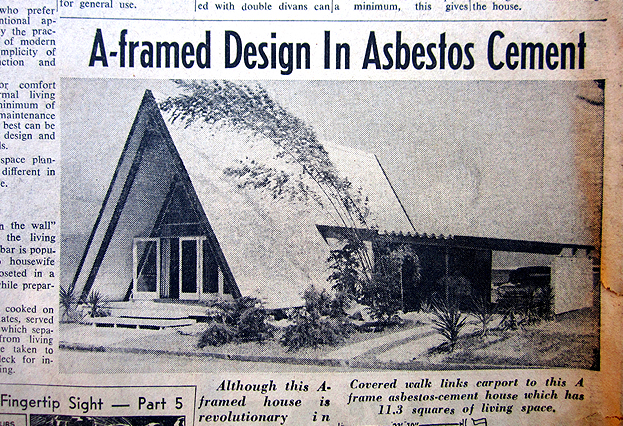Search
Recent comments
- niet...
3 hours 3 min ago - butt out bibi....
4 hours 32 min ago - progress....
4 hours 40 min ago - sergei karaganov....
6 hours 45 min ago - responsibility....
10 hours 29 min ago - the systems....
11 hours 7 min ago - the non-final solution....
15 hours 11 min ago - no intent....
23 hours 51 min ago - george in exile....
1 day 29 min ago - he can't write....
1 day 2 hours ago
Democracy Links
Member's Off-site Blogs
back in the news: asbestos...

Some Sydney homes may have also been insulated with the same dangerous form of asbestos that was pumped into the so-called Mr Fluffy homes in Canberra.
The Mr Fluffy insulation company installed loose-fill asbestos in the roof spaces of more than 1,000 homes across the ACT during the 1960s and 1970s.
A Commonwealth-funded clean-up program began in the 1980s but some cleared homes have been found to contain potentially deadly remnant fibres.
Now it has emerged that Mr Fluffy's methods of pumping in asbestos in its most dangerous form into roof spaces may have been much more widespread.
The evidence, contained in a newly-unearthed government report, suggests that for years, another company might have been using similar methods in Sydney homes.
In 1968 a federal health official was asked by the Commonwealth's Director of Public Works to provide advice on the health aspects of Mr Fluffy loose-fill asbestos.
The official, Arthur Spears, assessed the product being sold by Mr Fluffy owner Dirk Jansen as dangerous.
"It is considered desirable that D Jansen and company should be dissuaded or even prevented, if possible, from using asbestos fluff as insulation material in houses," Mr Spears said in the letter.
"Not only are men being unnecessarily exposed to a harmful substance in the course of their work, which is against the best public health practises, but there is evidence that community exposure to asbestos dust is undesirable.
reads more: http://www.abc.net.au/news/2014-08-01/mr-fluffy-sydney/5642608
Picture at top from Gus's collection of useless old newspapers (circa 1960s)...
- By Gus Leonisky at 10 Aug 2014 - 9:26am
- Gus Leonisky's blog
- Login or register to post comments
a unique challenge...
Welcome from Head of The Asbestos Response Taskforce, Andrew Kefford
The Asbestos Response Taskforce was established to provide a coordinated and compassionate response to the lasting impacts of loose-fill asbestos in Canberra homes. As head of the Taskforce I am committed to providing clear advice and practical assistance.
My early discussions with a number of affected people has demonstrated how unique each person’s story is. Although there is a common connection to a Mr Fluffy home, there is no single answer, or simple response that will suit everyone’s particular circumstances. To that end I expect my team to be working closely with the community over coming weeks and months.
In many ways this is a unique challenge. There is nowhere else in Australia experiencing the wide-spread impact of loose-fill asbestos in such a large number of homes as is the case in the ACT. However in other ways it is not dissimilar to many natural disasters that strike communities across Australia. We have families, households and small businesses, all impacted by something outside their control. The effects may be emotional, psychological, financial or health related. People are understandably worried, confused, nervous about the future and looking for support and guidance on the best next steps.
See also: http://www.yourdemocracy.net.au/drupal/node/20408?size=thumbnail
mr fluffy...
Authorities are looking to study the health impacts of living in a house contaminated with Mr Fluffy asbestos insulation, acting chief health officer Andrew Pengilley told homeowners at a health forum on Sunday.
About 200 people attended the forum in Belconnen, the second meeting of residents worried about their health and their children’s health as a result of living in contaminated homes.
Dr Pengilley said the research would be difficult because the mesothelioma register dated to the 1980s. The dangerous loose-fill insulation was installed from the late 1960s through to the 1970s. He also said it would be difficult to track down the people who previously lived in Mr Fluffy houses.
Read more: http://www.canberratimes.com.au/act-news/health-effects-of-mr-fluffy-asbestos-exposure-to-be-studied-20140803-10003o.html#ixzz39wOxVDgC
mesothelioma...
Chris Georgiou is suing the Federal Government in the New South Wales Dust Diseases Tribunal, alleging it was negligent because it failed to stop the installation of the Mr Fluffy product in homes and failed to warn residents of the health dangers.
His lawyer said if successful, the case could pave the way for many more claims.
Mr Georgiou, a retired jeweller, told the ABC he did not have a safe at home, so he used to hide valuable items in his roof space.
"I didn't want to have them in the house. So I hid them in the roof, on top of the fluffy asbestos," he said.
"I used to use a ladder or a chair and I would put my hand in. So I was touching the asbestos."
Mr Georgiou also went into the roof space several times with his son to install pink batts and aluminium foil.
"I was full of fluffy on my clothes, I had to change and put them in the bin for washing," he said.
He worries that his son, who lives in America, might also get the deadly cancer.
"It's a hidden sickness. I don't know how long it will take him to know he's safe. How does he know he's safe?" Mr Georgiou said.
http://www.abc.net.au/news/2014-12-01/mr-fluffy-mesothelioma-sufferer-brings-case-against-commonwealth/5932104
See also: http://www.yourdemocracy.net.au/drupal/node/20408